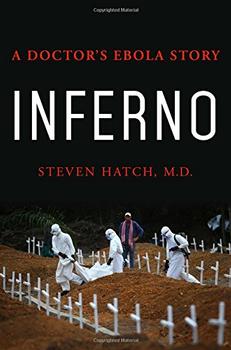Summary | Excerpt | Reviews | Beyond the Book | Readalikes | Genres & Themes | Author Bio

A Doctor's Ebola Story
by Steven Hatch1
THE VESTIBULE
A screaming comes across the sky. It has happened before, but there is nothing to compare it to now.
—Thomas Pynchon, Gravity's Rainbow
This is a horror story. And as if someone from central casting were pulling the strings, this horror story begins with a small child happily playing right outside his home.
Meliandou is a small village of a few hundred inhabitants living in approximately thirty rustic dwellings in the hinterlands of Guinea, a satellite of the city of Guéckédou, a place to which the villagers, mostly farmers, come to sell their produce in the Nzérékoré Region, the easternmost province of a country shaped almost like an apostrophe that lost its footing in the middle of a sentence and was falling forward. Meliandou's North American equivalent would be described as "sleepy" and perhaps "idyllic." Although it would be naïve to think that Meliandou's people have lived a content, pastoral existence for centuries or even decades, as of the early twenty-first century, a quiet kind of peacefulness could be found there.
Emile Ouamouno was the beneficiary of this relative prosperity. The child of Etienne and Sia, Emile was growing up as children do in a relatively sheltered environment, exploring the natural world around him, which in the depths of the West African rain forest provided no end of wonders for a curious two-year-old. A picture of the three of them can be found on the Internet. Although they aren't smiling, one gets the sense that they are satisfied with their lives. They're an unmistakably beautiful family. Sia is on the right, her left hand on her hip, wearing an abstract-patterned light dress, with long white earrings and a yellow bead necklace. Her hair is close cropped. Etienne occupies the center, wearing a red-and-black soccer jersey. And Emile sits upright, staring into the camera, held in the crook of his father's right arm, eyes wide, the chubby cheeks of toddlerhood not yet dissipated. The graininess of the picture makes it look like it could have been taken in the 1960s, but it is from 2013.
Along with other children, Emile used to frequent a large tree at the periphery of the village. The tree was a natural jungle gym, with a hollow at its center large enough for a grown man to walk inside and even climb up into. By the news reports, the kids used to love playing around the tree. Again, you can find pictures of this tree in a few seconds with a Google search. It provided a natural setting for children to spend their afternoons doing what kids should do, especially a child of Emile's age.
It wasn't only children who utilized the tree for its size and the protection it offered. Farther up in the hollow, a nest of Angolan free-tailed bats had quietly taken up residence. The bats belong to the insect-feeding species Mops condylurus, and they are extremely common throughout much of sub-Saharan Africa. Their droppings would fall to the ground and mingle with the soil. With the heat of the jungle in the dry season, you would hardly have noticed the guano at all. And nobody did. Certainly the children didn't, focused as they were on the joys of playing. But it was this interface of child-bat-guano that may have led to Emile Ouamouno becoming Patient Zero of the West African Ebola outbreak in December 2013, the first spark in a fire that would rage for months and then years, a child who became the nexus of a tragedy in which thousands would die, thousands more would be maimed, and tens of thousands of others would feel its shockwaves without ever coming near the agent that transmitted such suffering.
* * *
The screaming first came across the sky in 1976. Quite remarkably, two simultaneous outbreaks took place hundreds of miles apart, one in the southern part of Sudan, the other in Zaire, the country we now call the Democratic Republic of the Congo, or DRC. The Sudan outbreak led to nearly three hundred infections, and half of the patients died. The Zaire epidemic led to about the same number of infections, but in this outbreak nine of every ten patients died. The identification of this strange and very deadly new virus would take place in state-of-the-art facilities designed to deal with the most lethal pathogens on the planet—so-called Biosafety Level 4 laboratories. In short order Ebola would develop a reputation among the scientists who studied it as the most fearsome of a small group of truly terrifying infectious agents.
Excerpted from Inferno by Steven Hatch. Copyright © 2017 by Steven Hatch. Excerpted by permission of St. Martin's Press. All rights reserved. No part of this excerpt may be reproduced or reprinted without permission in writing from the publisher.
Your guide toexceptional books
BookBrowse seeks out and recommends the best in contemporary fiction and nonfiction—books that not only engage and entertain but also deepen our understanding of ourselves and the world around us.